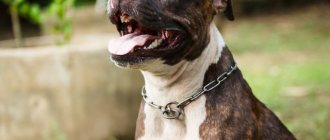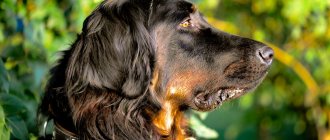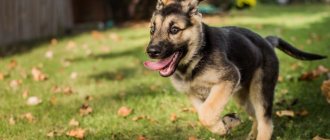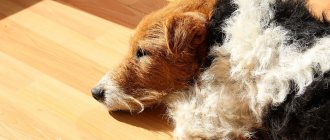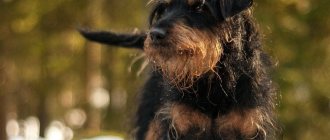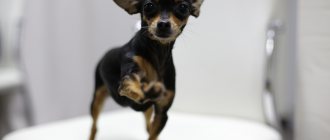Raising a dog is about developing correct behavior. This is the basis for successful training. Training is a set of activities aimed at training specific teams. It is necessary to start raising a puppy from the very first days of his appearance in the house. If you work with your pets from a very early age, then you are on the right track.
The name “Shih Tzu” means little lion, but there is nothing ferocious about this dog breed. The breed was bred solely to be companions. Shih Tzus are affectionate, sociable family dogs that love nothing more than to follow their owners from room to room. Since ancient times, they have made themselves comfortable on the laps of all walks of life, even emperors! They make excellent pets that get along well with other animals and children.
- Country of Origin : China
- Height at withers : male: 20 – 28 cm, female: 20 – 28 cm
- Weight : female: 4 – 7.2 kg, male: 4 – 7.2 kg
- Lifespan : 10-16 years
- Use : companion dog
Raising a puppy
Nowadays, decorative breed dogs, such as Shih Tzu, Yorkshire terriers, pugs, toy terriers, Chinese crested dogs and others, are becoming increasingly popular.
This is understandable: despite their small size, they have by no means a cat’s attachment to their owner and developed intelligence, which allows them to feel like the owner of a full-fledged dog with all the ensuing positive consequences. Plus, there is a minimum amount of space taken up in the apartment, low food costs and the ability to easily take your dog with you on any trip. For many, such a dog becomes the first one raised from a very early age, so a lot of questions inevitably arise and a lot of mistakes are also inevitably made in education. I would like to give some tips to make life a little easier for new owners and help them raise a mentally and physically healthy animal. It is quite possible that many of the tips will seem too obvious to experienced dog lovers, but believe me, I want to touch on exactly those topics that most often have to be considered when communicating with decorative owners.
There are two key points that need to be clearly understood when getting such a dog. On the one hand, despite the apparent frivolity, this is a full-fledged dog, which, if improperly raised, can cause no less problems for its owner than a spoiled bullmastiff. On the other hand, decorative breeds are no less trainable than working breeds, and sometimes working with them is even more enjoyable.
It follows from this that you should never neglect training: your puppy can be taught at least a few basic commands very quickly. Yes, the requirements for such a dog will be much more lenient than for large breed dogs, and the set of commands will also be different. But, like a working dog, a decorative dog needs self-realization, the opportunity to feel needed and in demand, and only competent training can give this feeling.
Another point important for the full development of a dog is proper socialization. I have repeatedly observed how owners nervously grab their pets in their arms when they see a dog approaching. In particularly advanced cases, the dog spends most of the walk in his arms, if not his entire life. I understand that meeting a large dog can be unpleasant, and the owner is motivated by good intentions - to protect the pet. But we also need to be aware of the far-reaching consequences of such behavior, and the consequences are not always pleasant. When a dog is limited in communication with its relatives, when it does not have the opportunity to play, and therefore learn to solve its problems on its own, it grows up completely unadapted to life in the world in which it is destined to live by nature. Cowardice, pathological fears, uncontrollable barking and failure to follow commands are only part of the difficulties that the owner may later encounter. I'm not even talking about how the dog himself will feel in this incomprehensible and hostile world. Believe me, not all large dogs are eager to devour your Yorkie - most just want to play.
Pros and cons of the breed
The advantages of the breed include the following:
- small size;
- no need for long walks;
- lack of aggression;
- hypoallergenic wool;
- no dog smell;
- unusual appearance;
- ease of maintenance in the apartment;
- the ability to easily get along with other pets;
- the extraordinary intelligence of an animal.
The disadvantages of the breed are:
- too much gullibility;
- the need for constant coat care;
- tendency to allergies;
- poor heat tolerance;
- the need to consult a veterinarian;
- frequent visits to special haircut centers.
First steps on four legs at home
Raising a properly raised dog and instilling in it the necessary training skills is an art that requires love for your pet, patience, endurance, time and certain knowledge. Raising a Shih Tzu puppy should begin from the first minutes of its appearance in the family.
At first, the main attention should be paid to making the puppy comfortable in the house, accustoming him to the place where he will sleep and eat. You need to immediately clearly decide where the dog is not allowed to go and strictly monitor compliance with this requirement.
Setting goals
Raising a puppy should begin even before purchasing it.
It is advisable that the future owner, when choosing a small plush bun from the litter in the kennel, has a clear idea of what to do with the dog in the future, and what goal to devote his life and time to achieving.
Thanks to its uniquely long and thick coat, the dog can become the pride of the whole family when participating in exhibitions.
In the media there are photographs of an agility champion dog and a surfing prize-winning dog.
If an animal feels motivated, it is capable of much. The other side of the coin called “purchasing a Shih Tzu” is also present.
It can be briefly described by the principle: if the owner does not raise the acquired dog, the dog will raise the owner.
A miniature lion is capable of subordinating both one person and the entire family to its desires and whims.
To prevent this from happening, dog experts recommend not leaving your dog’s upbringing to chance.
A small descendant of a wolf must be aware of the capabilities of the pack surrounding him and his place in it.
It is naive to think that, living in the company of several people, a Shih Tzu will respect them just because he is fed and petted.
On the other hand, the dog is a sociable member of the group; it cannot stand being alone. And the third point that you need to pay attention to is the social element.
The dog should not turn the apartment into a nursery, and at the same time he should feel confident, comfortable and at ease in the house.
The relationship between Shih Tzu and owner is often based on mutual respect, sympathy and devotion. Building such a model of communication can become the goal of raising a puppy.
Walking routine and behavior skills
After your puppy is completely comfortable in the house, training of the Shih Tzu dog breed begins. It is important to accustom your baby to a walking routine. It is still difficult for him to endure for a long time, therefore, the first walk should be in the morning, as soon as he wakes up. Up to a year, you need to walk your dog every few hours, gradually increasing the intervals, as well as about twenty minutes after meals and immediately before bed.
As a rule, the Shih Tzu is walked on a leash up to two meters long, so that on the one hand there is an opportunity to control it, and on the other hand, the right to choose a place. If the baby relieves himself in an unauthorized place, he does not need to be frightened or punished, just move him and show him where this can be done.
It is customary to start walking a puppy at eight to ten weeks of age. It is necessary to raise a Shih Tzu dog in such a way that the baby understands that you can only relieve yourself outside. As they grow older, the intervals between toilets will lengthen - your pupil will learn to endure.
Health and major diseases
If the pet does not have serious genetic diseases, it is properly kept and cared for, the dog can live up to 17 years, remaining energetic and active. Long hair causes some inconvenience for this breed. It often hides festering wounds, and the animal can also swallow fur.
The dog has a long body and short limbs. Jumping from furniture, he can get a fracture or damage his spine. Spinal injuries often lead to partial paralysis of the dog. To prevent the dog from breaking something, the furniture is arranged so that the animal does not jump from object to object. Once the dog reaches old age, it is necessary to carry it through stairs so that it does not get injured. Shih Tzus are prone to eye and dental diseases. Due to the structure of the muzzle, it has an open orbit of the eyes, and the eyes rest only on the masticatory muscle. Pressure causes the eyeball to protrude.
You should not straighten the eye yourself to avoid damaging it. In these cases, you need to contact your veterinarian. Often this decorative breed develops conjunctivitis, problems arise with the development of teeth, their curvature and loss.
The decorative dog is predisposed to defects in kidney development, heart defects, kidney stones and other diseases.
Teaching commands and tricks
Training and consolidation of the skills of basic or standard commands ends around the year. Your pet no longer just understands what is required of him, but also knows some words - you have learned to understand each other.
From the age of one year, you can begin training for professional teams. How nice it is to know that thanks to your patience and love, the baby understands the commands addressed to him: “Come to me!”, “Sit!”, “Lie down!”, as well as other commands that you taught him!
And raising a Shih Tzu puppy is not over yet, because you want the baby to be able to do something special that others cannot. So go for it! Now is the time to teach your pet different tricks that you like, because Shih Tzus are very grateful and capable students!
Photo gallery
A Shih Tzu pet can be a very loyal and devoted friend, and to prevent it from getting on your head, it is enough to follow the simple rules outlined in this article.
Raising and training a Shih Tzu
In ancient China there was a breed of dog that was intended only for the imperial court. Cute and mischievous Shih Tzu entertained the ruler and his entourage. The sale of Shih Tzu to ordinary people was strictly prohibited. Because it is not appropriate for commoners to have an imperial dog at home.
These days, the Shih Tzu, along with other decorative dogs, is very popular. And this is not strange, because she has many advantages for a city dweller.
Natural character of the chrysanthemum dog
The cute size, plush appearance and cheerful, friendly disposition of the dog mislead many.
At first glance, it may seem that a Shih Tzu is no different from a cozy plush toy that you can forget in some corner, and then remember about it, find it, be happy and cuddle it.
However, according to experts, representatives of this breed have a powerful intellect, a strong body and developed muscles.
The dog has a high neck, so its posture is striking in dignity, and its behavior reveals deep self-respect and even arrogance.
Animals are distinguished by endurance, agility, and intelligence. Puppies and young dogs are famous for their activity, mobility, and love of games.
Thanks to such qualities and natural impressiveness, the Shih Tzu can afford friendliness and openness in relationships.
An independent, freedom-loving character, based on an energetic disposition and natural courage, can become the basis for a dog’s leading position in the family.
It depends on the owner who this creature will become: a companion and assistant or a tyrant and dictator.
